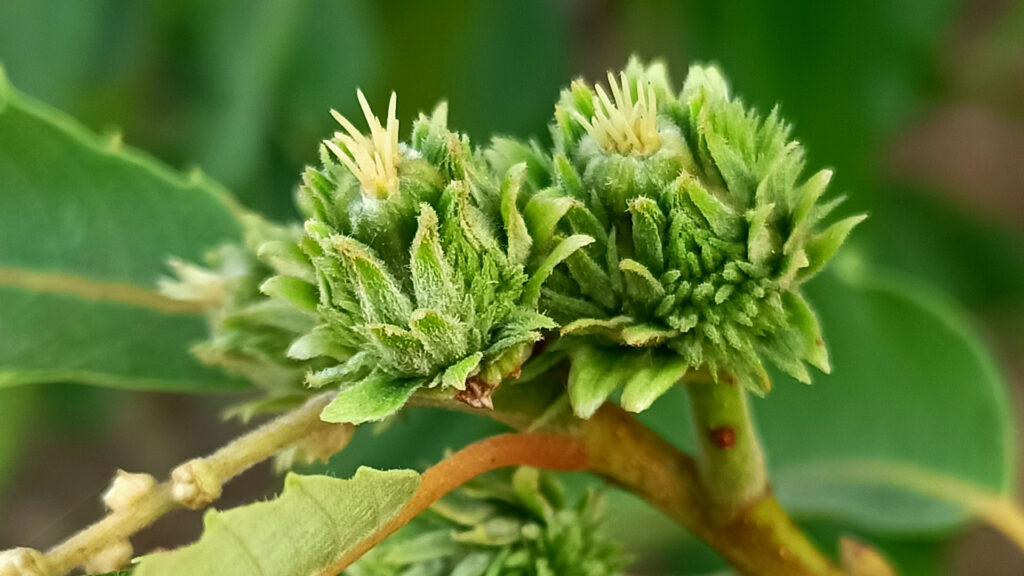
Castagno
E’ una pianta molto diffusa nelle regioni dell’emisfero settentrionale , si sviluppa in una fascia di altitudine compresa tra i 300 e i 900m su terreni acidi e ben permeabili, e date le dimensioni non è una pianta da giardino.
Appartiene alla famiglia delle Fagacee, può’ raggiungere un altezza fino a 30mt, si riproduce per seme e per innesto e fruttifica dopo circa 20 anni dall’impianto. Il fusto e’ robusto con corteccia screpolata, le foglie hanno un margine seghettato, i fiori maschili sono piccoli di colore bianco gialliccio e quelli femminili sono di colore verde.
I suoi frutti “le castagne” sono protetti da un involucro spinoso, il riccio, che a maturità si apre lasciando cadere i frutti durante il periodo autunnale. Le castagne sono state uno degli alimenti principali per molte generazioni del passato, considerate un cibo povero, ma molto apprezzate tutt’ora per l’ottima farina adatta alla preparazione di dolci, polente e frittelle.
Pare che l’origine di quest’albero, introdotto in Europa molti secoli fa, sia da ricercare in Persia e Medio oriente e già Omero e Virgilio ne parlano nelle loro opere; Plinio racconta come le castagne tostate dessero una farina in grado di produrre un pane speciale del quale si nutrivano le sacerdotesse. Una curiosa leggenda racconta come sotto i rami di un castagno secolare trovò rifugio la regina Giovanna d’Aragona insieme al suo seguito di cavalli e cavalieri, e l’albero tutt’ora esistente alle falde dell’Etna è conosciuto come “il castagno dei cento cavalli”.
Chestnut
It is a very common plant in the regions of the northern hemisphere, it grows in an altitude range between 300 and 900m on acid and well permeable soils, and given its size it is not a garden plant.
It belongs to the Fagaceae family, can reach a height of up to 30m, reproduces by seed and by grafting and bears fruit about 20 years after planting. The stem is robust with cracked bark, the leaves have a serrated edge, the male flowers are small yellowish white and the female ones are green.
Its “chestnuts” fruits are protected by a thorny shell, the hedgehog, which opens when ripe, letting the fruits fall during the autumn period. Chestnuts have been one of the main foods for many generations in the past, considered a poor food, but still much appreciated today for the excellent flour suitable for the preparation of sweets, polenta and pancakes.
It seems that the origin of this tree, introduced in Europe many centuries ago, is to be found in Persia and the Middle East and Homer and Virgil already speak of it in their works; Pliny tells how the toasted chestnuts gave a flour capable of producing a special bread on which the priestesses ate. A curious legend tells how Queen Giovanna of Aragon found refuge under the branches of an ancient chestnut tree together with her retinue of horses and knights, and the tree still existing at the foot of Etna is known as “the chestnut of the hundred horses”
Châtaigne
C’est une plante très commune dans les régions de l’hémisphère nord, elle pousse dans une fourchette d’altitude entre 300 et 900m sur des sols acides et bien perméables, et vu sa taille ce n’est évidemment pas une plante de jardin.
Il appartient à la famille des Fagacées, il peut atteindre jusqu’à 30m de haut, il se reproduit par graines et par greffage et porte des fruits environ 20 ans après la plantation. La tige est robuste avec une écorce fissurée, les feuilles ont un bord dentelé, les fleurs mâles sont petites blanc jaunâtre et les femelles sont vertes.
Ses fruits “châtaignes” sont protégés par une enveloppe épineuse, le hérisson, qui, à maturité, s’ouvre, laissant tomber les fruits pendant la période automnale. Les châtaignes ont été l’un des aliments de base pendant de nombreuses générations dans le passé, elles étaient considérées comme un aliment pauvre, encore très appréciées aujourd’hui notamment pour l’excellente farine adaptée à la préparation de galettes, polenta et crêpes.
Il semble que l’origine de cet arbre, introduit en Europe il y a plusieurs siècles, se trouve en Perse et au Moyen-Orient et Homère et Virgile le mentionnent déjà dans leurs ouvrages ; Pline raconte comment les châtaignes grillées donnaient une farine capable de produire un pain spécial sur lequel mangeaient les prêtresses. Une curieuse légende raconte comment la reine Giovanna d’Aragon a trouvé refuge sous les branches d’un ancien marronnier avec sa suite de chevaux et de chevaliers, et l’arbre qui existe encore au pied de l’Etna est connu comme “le marronnier des cent chevaux”

